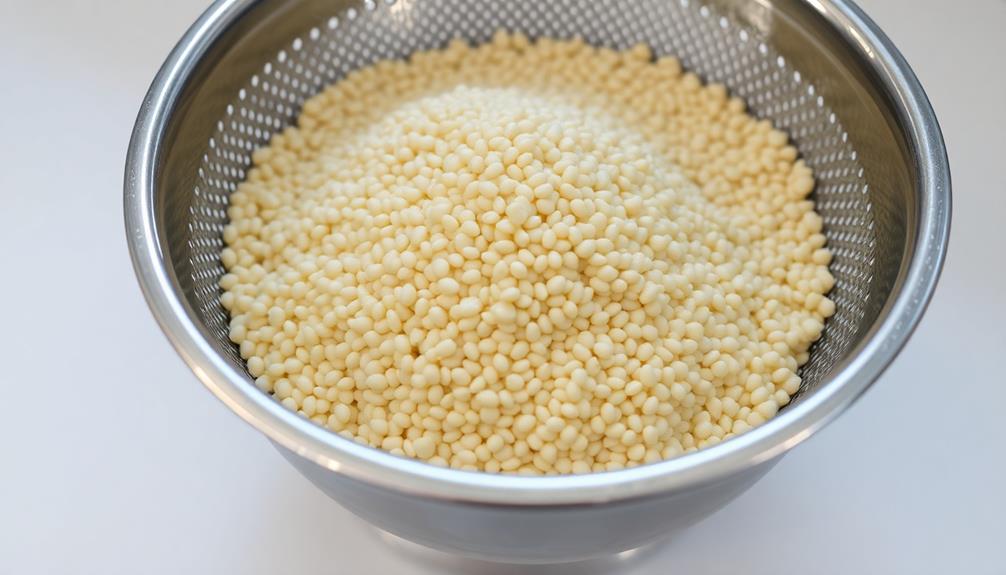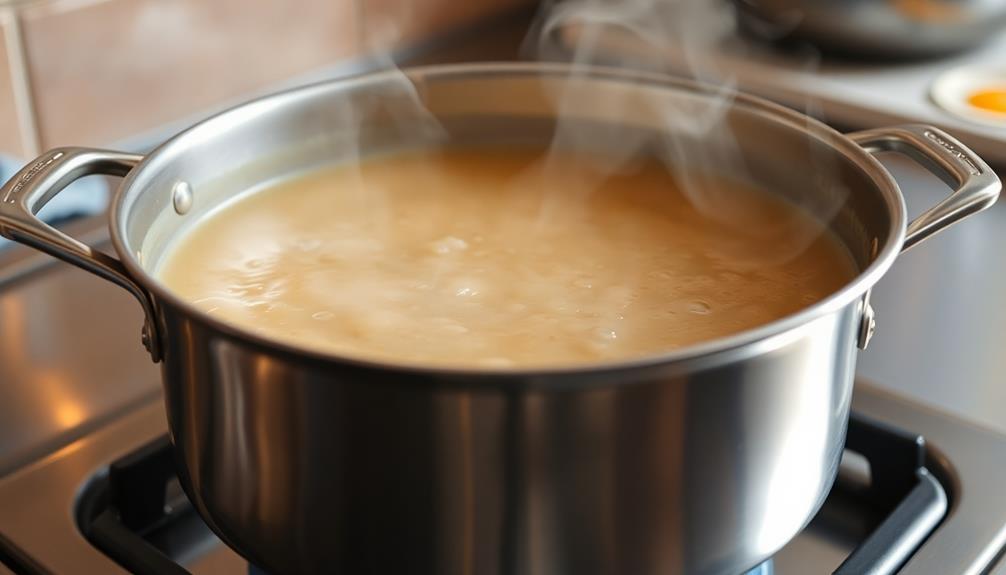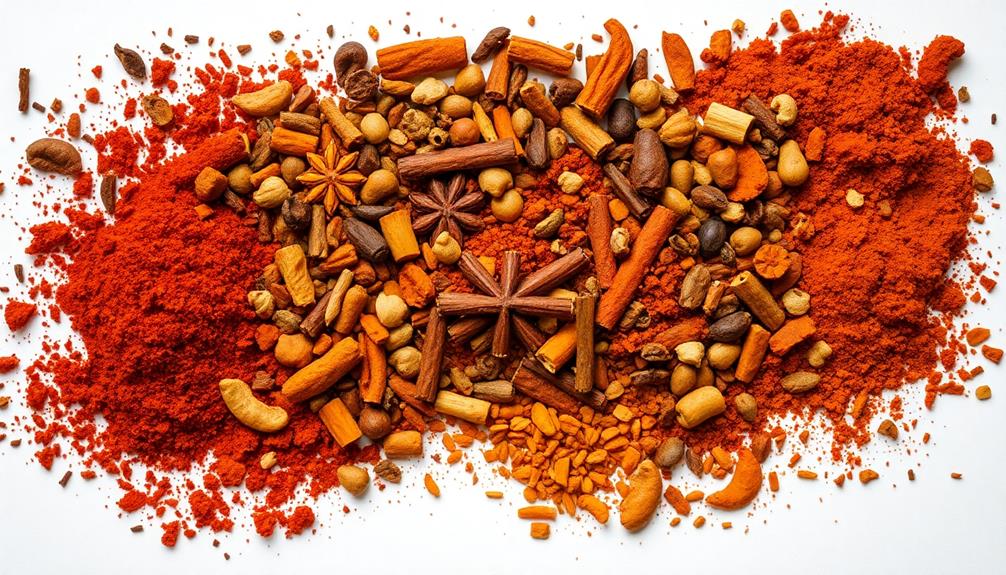Genfo, the traditional Ethiopian porridge, is a nourishing and culturally significant dish you'll love. Made from teff or other grains, it has a rich, creamy texture and can be topped in countless ways – from honey and butter to spiced clarified butter and roasted nuts. Often enjoyed during family gatherings and celebrations, genfo represents the concept of "sharing" in Ethiopian culture. It's a hearty breakfast that provides energy through carbohydrates and essential vitamins and minerals. To make it, simply soak the grains, then cook them in boiling water until smooth and creamy. Keep reading to discover more about this beloved Ethiopian staple.
Key Takeaways
- Genfo is a traditional Ethiopian porridge made primarily from the nutrient-dense teff grain, known for its smooth, creamy texture.
- It holds significant cultural importance, often served during family gatherings and celebrations in Ethiopian households.
- Genfo is a rich source of carbohydrates, providing energy, and can be fortified with proteins and vitamins.
- The preparation involves soaking and rinsing the grains, then cooking them on low heat with frequent stirring for a smooth texture.
- Genfo can be customized with various toppings, such as honey, butter, spiced clarified butter, milk, yogurt, roasted nuts, and dried fruits.
History
Genfo, a traditional Ethiopian porridge, has a rich history deeply rooted in the country's culinary heritage. This nourishing dish has been a staple in Ethiopian households for generations, with its origins tracing back to ancient times.
Traditionally, genfo was prepared using teff, a nutrient-dense grain that has been a dietary mainstay for the Ethiopian people for centuries. The process of making genfo involves carefully roasting the teff grains, then grinding them into a fine flour and cooking it into a thick, creamy porridge. The benefits of teff include its high levels of iron, calcium, and protein, making it a valuable addition to the diet, especially for those following a vegetarian or vegan lifestyle. Additionally, teff is gluten-free, making genfo a suitable dish for those with celiac disease or gluten sensitivities. Its slow-releasing carbohydrates also provide a steady source of energy, making genfo a popular choice for athletes and those with active lifestyles.
This simple yet delicious dish was often served during special occasions and celebrations, reflecting its important role in Ethiopian culture. Today, genfo continues to be a beloved comfort food, passed down from one generation to the next, embodying the traditions and flavors that make Ethiopian cuisine so unique and captivating.
Recipe
Genfo, also known as porridge, is a traditional Ethiopian dish that has been a staple food in the country for centuries. It's a hearty and nutritious meal that can be enjoyed for breakfast, lunch, or dinner.
The texture of genfo can vary from a thick, creamy consistency to a more liquid-like porridge, depending on personal preference and the specific recipe used. The versatility of genfo lies in its ability to be customized with a variety of toppings and accompaniments, making it a dish that can be tailored to individual tastes.
Whether enjoyed on its own or as part of a larger meal, genfo is a comforting and satisfying dish that has become deeply ingrained in Ethiopian culinary traditions.
Ingredients:
- 1 cup whole-grain teff flour
- 4 cups water
- 1/4 teaspoon salt
Cooking Instructions:
In a large saucepan, bring the water to a boil over high heat. Gradually whisk in the teff flour, stirring constantly to prevent lumps from forming.
Reduce the heat to low and continue to cook, stirring frequently, for 15-20 minutes, or until the mixture has thickened to your desired consistency.
Tips:
When cooking genfo, it's important to use a gentle heat and to stir the mixture constantly to ensure a smooth and creamy texture.
For a thicker porridge, you can reduce the amount of water used, while a thinner consistency can be achieved by adding more water. Genfo can be served warm or at room temperature, and it pairs well with a variety of toppings such as honey, butter, or spiced clarified butter (niter kibbeh).
Cooking Steps
Soak the grains in water overnight to soften them.
Drain and rinse the soaked grains before cooking them over low heat.
Add milk or yogurt, and top with roasted nuts and dried fruit for a delicious and nutritious porridge.
Step 1. Soak Grains in Water Overnight

Usually, you'll want to soak the grains in water overnight. This helps to soften them and make them easier to cook. Simply place the grains in a large bowl and cover them with plenty of water. Let them sit at room temperature for 8-12 hours, or overnight.
The soaking process helps to break down the grains, making them more digestible. It also helps to remove any impurities or contaminants that may be present.
Once the grains have soaked, you can drain them and rinse them thoroughly before cooking.
Soaking the grains is an important step in the genfo-making process. It helps to ensure that the final porridge has a smooth, creamy texture.
Be sure to allow enough time for the grains to soak, as this will make the cooking process much easier and more efficient.
Step 2. Drain and Rinse Soaked Grains

After soaking the grains overnight, you'll want to drain and rinse them thoroughly. This step is crucial to remove any excess water and impurities that may have accumulated during the soaking process.
Simply place a strainer or colander in the sink and carefully pour the soaked grains into it. Gently shake the strainer to allow the water to drain off completely.
Once drained, give the grains a quick rinse under cool running water, lightly stirring them with your hands to ensure they're fully rinsed. This rinsing step helps to remove any remaining starch or impurities, leaving you with clean, ready-to-cook grains.
Be sure to give the grains a few shakes to remove any excess water before proceeding to the next step in the recipe.
With the soaked and rinsed grains, you're now ready to move on to the cooking process and create a delicious batch of genfo.
Step 3. Cook Soaked Grains Over Low Heat

With the soaked and rinsed grains, you'll begin cooking them over low heat. In a large pot, combine the grains and enough water to cover them by about an inch. Bring the pot to a gentle simmer, making sure to stir occasionally to prevent sticking or burning.
As the grains cook, they'll gradually release their natural starches, creating a creamy, porridge-like consistency. Adjust the heat as needed, keeping it low to medium-low, and continue simmering for 30-45 minutes, stirring frequently.
The exact cooking time may vary depending on the type of grains you're using, so keep an eye on the texture and consistency.
Once the grains have reached your desired doneness, remove the pot from the heat. You can now season the genfo with your preferred spices, such as cinnamon, cardamom, or nutmeg, to enhance the flavor.
Serve the warm, comforting porridge and enjoy its nourishing goodness.
Step 4. Add Milk or Yogurt

To further enhance the creamy texture and flavor of the genfo, you can add a splash of milk or a dollop of yogurt. This extra ingredient will lend a lovely, rich creaminess to the porridge.
If using milk, start with a few tablespoons and gradually increase the amount to reach your desired consistency. For a tangy twist, try stirring in some plain yogurt. The yogurt won't only thicken the genfo but also provide a delightful tanginess that pairs beautifully with the sweetness of the porridge.
Whichever dairy product you choose, be sure to stir it in gently over low heat until fully incorporated. This will ensure the genfo maintains its smooth, velvety texture.
You can also experiment with different types of milk, such as plant-based or flavored varieties, to customize the flavor profile to your liking. Just remember to adjust the amount as needed to achieve your perfect genfo.
Step 5. Garnish With Roasted Nuts, Dried Fruit

Once you've achieved your desired consistency with the addition of milk or yogurt, it's time to elevate the genfo even further.
Garnishing your porridge with a variety of roasted nuts and dried fruit can take the flavors to new heights.
Begin by toasting a handful of your favorite nuts, such as almonds, cashews, or walnuts, in a dry pan over medium heat.
Stir frequently until they become fragrant and lightly browned. Allow the nuts to cool, then roughly chop them.
Next, select an assortment of dried fruits, such as apricots, figs, or raisins, and dice them into bite-sized pieces.
The sweet and chewy textures of the dried fruit will provide a lovely contrast to the creamy genfo.
Final Thoughts
Genfo, a time-honored porridge, serves as a nourishing staple in many households. This versatile dish can be enjoyed year-round, but it truly shines during celebratory occasions. The final touches, such as roasted nuts and dried fruit, elevate the experience, adding texture, flavor, and visual appeal.
As you savor the last spoonful, you can't help but feel a sense of satisfaction. Genfo's comforting warmth and wholesome goodness nourish both body and soul. It's a reminder of the importance of tradition and the power of simple, wholesome ingredients.
Looking ahead, you might consider experimenting with different toppings or even trying your hand at making genfo from scratch. The possibilities are endless, and the joy of sharing this beloved dish with loved ones is unparalleled.
Embrace the comfort and joy that genfo brings, and let it continue to be a cherished part of your culinary journey.
Frequently Asked Questions
What Is the Nutritional Value of Genfo (Porridge)?
Porridge is a nutritious breakfast option, providing a balance of complex carbohydrates, protein, and fiber. It's packed with vitamins and minerals that can fuel your day and support overall health. Enjoy porridge for a wholesome, satisfying start to your morning.
Can Genfo (Porridge) Be Made With Alternative Grains?
Absolutely, you can make porridge with alternative grains. Try using oats, quinoa, millet, or buckwheat for a tasty and nutritious twist on the classic dish. The possibilities are endless when it comes to crafting your perfect porridge.
How Long Can Genfo (Porridge) Be Stored For?
How long it can be stored depends on the ingredients used. With proper storage, the porridge can last 3-5 days in the fridge. However, you'll want to consume it within that timeframe for best quality and food safety.
Is Genfo (Porridge) Suitable for People With Dietary Restrictions?
Yes, genfo can be suitable for people with dietary restrictions. Depending on the ingredients used, it can accommodate various dietary needs, such as gluten-free, dairy-free, or vegan. Always check the recipe to ensure it meets your dietary requirements.
What Are the Health Benefits of Consuming Genfo (Porridge)?
Consuming porridge provides a range of health benefits. It's packed with fiber, which promotes digestive health and can help you feel fuller for longer. Plus, it's a great source of complex carbs to fuel your day.









